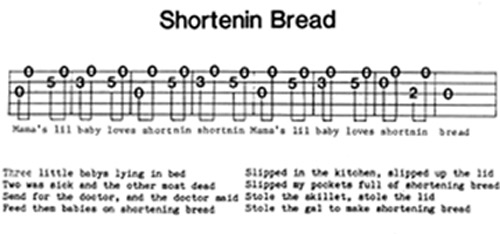
By Wayne Erbsen
Come into the closet. As you nestle yourself in amongst the overcoats and umbrellas, you may be wondering why I called you here. A lot of people think that the only real banjo playing goes on at the Opry or at some far away stage with lights glittering from above. Not so. Some of the best banjo picking comes from inside of a well-stuffed closet. Of course, the sound does tend to get a little muffled in there, but the feeling is right, and the motives are pure. What closet picker could ever be accused of being on an “ego trip”?
The lowly closet picker has long been forgotten in banjo history. This article is designed to render the rudiments of banjo playing painfully easy. It’s aimed not only at closet banjo players everywhere, but also at those who never dared set foot in a closet with their banjo — the raw, untutored, but trainable banjo picker. In the coming months we will lay aside formal teaching techniques as we sit in our closets together: you in yours and I in mine.
If I may be permitted to criticize current banjo pedagogy, of which I am a part, I would say that entirely too many teachers and writers of banjo books start their would-be students off at too difficult a level. From there they progress up in difficulty until only themselves and a few trusted cronies can decipher what they are trying to teach. Most beginners are simply not going to play Foggy Mountain Breakdown in three keys (without a capo) in the first or second lesson. It not only takes time to get to that point, but it also takes starting out simply enough so beginners can understand what they are playing before they progress to the next level.
So without any additional verbiage, let’s begin at the beginning. Three-finger banjo playing consists of a series of rolls or finger patterns which recur in the music. If you break down each roll, you will find usually one melody note and several rhythm and harmony notes. Most of these rolls consist of eight notes. The difficulty of three-finger picking is in plugging the eight-note pattern in the right slot.
To make things easier for the closet picker, we will use a four-note pattern, and will concentrate on using only two fingers, not three. After we learn to pick with two fingers, it will be easy to add the third finger. This style of picking with two fingers often goes by the name of “double-thumbing.”
The first tune we will try is Shortenin Bread. First, we must find the melody. Here is the basic melody to Shortenin Bread. Play it over and over with your thumb until you can play it with one eye shut.
When you can do that, follow each of the notes you just played with the first string played open, with your middle finger. The timing should be the same as you just played, only it should sound fuller.
 When you can play “Shortening Bread” to your satisfaction, try cooking up a pan of the stuff. And don’t forget to sweep the crumbs out of the closet!
When you can play “Shortening Bread” to your satisfaction, try cooking up a pan of the stuff. And don’t forget to sweep the crumbs out of the closet!
******
Wayne Erbsen has been teaching banjo, fiddle, guitar, and mandolin since dinosaurs roamed the earth (really, about 50 years). Originally from California, he now makes his home in Asheville, North Carolina. He has written 30 songbooks and instruction books for banjo, fiddle, guitar, and mandolin.


Wayne,
I just acquired a Vega, 19 feet 4 string Tenor. I know absolutely nothing about playing it. I want to buy your Banjo for Ignoramous book but everything I read is for 5 string Banjos. Can I use your book on a 4 string. Please help! I’m 69 and getting older by the day.
Thanks
Tim Pickett
Parma Michigan
Unfortunately a tenor banjo is an entirely different instrument than a 5 string banjo! There are books on tenor banjo out there, but we haven’t written any (yet). Good luck!